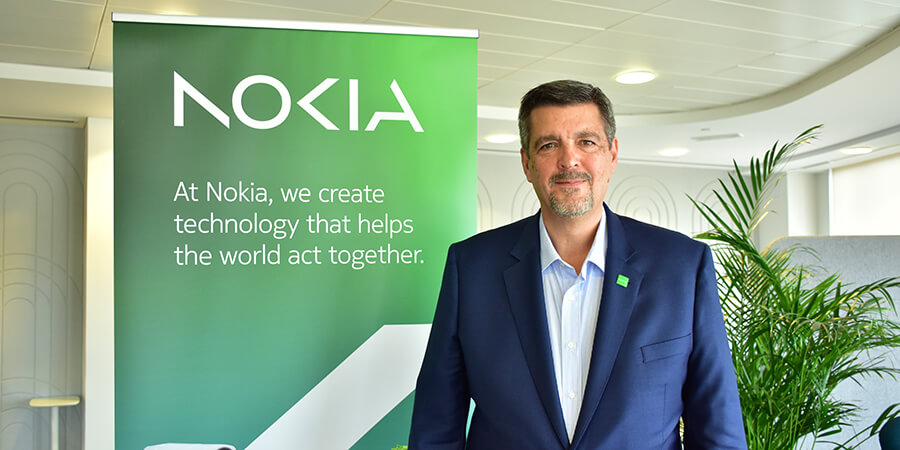In an exclusive interview with Telecom Review, Roque Lozano Barbero, Senior Vice President Network Infrastructure, Middle East & Africa, Nokia, highlighted the importance of collaboration, sustainability and network transformation in seizing the opportunities of digitalization.
How can network providers offer alternatives distinct from cloud platforms? What strategies can be employed to establish a collaborative infrastructure with hyperscale companies?
The focus is now on collaboration rather than competition, with cloud platforms creating new business opportunities for carriers. While traditional networks can deploy cloud services, they require fine-tuning to a great extent. Carriers that swiftly optimize their networks enable faster, more secure cloud services, giving them a significant market advantage. The transformation of networks to meet the demands of enterprise-focused cloud services will be a key differentiator, fostering a mutually beneficial relationship with web scalers.
Submarine cables play a pivotal role in connecting regions, with the Middle East serving as a crucial junction between the east and west. What are the notable submarine cable projects in the Middle East, and how will they impact the region's digital economy?
Submarine cables are vital components of connectivity between continents. The two main cable systems in this region are Equiano and 2Africa. Unlike many other cables passing through the region, these systems are dedicated to directing traffic to and from the MEA region, providing substantial capacity exceeding previous deployments. With over 100 terabits of communication speed, these cables offer connectivity opportunities, fostering the development of cloud services and attracting global players to the region.
Also read: Nokia’s 5 New Digital Enablers for Industrial Transformation
Nokia has achieved recognition in Sustainalytics' 2024 list of ESG Top-Rated companies. What are the key strategies that Nokia employed to attain this recognition?
Sustainability has always been a priority for Nokia, including addressing power consumption challenges through a holistic approach. Our Fixed Wireless Access (FWA) solution, Fiber for Everything, is testament to our vision— without digital, there is no green, and without green, there is no future. This ‘digital’ should be inclusive, which means that we have to deliver affordable solutions to the market.
An ideal example of delivering sustainable, high-quality broadband is our collaboration with fibertime to provide FTTH solutions to townships in South Africa. Where it was difficult to achieve an ARPU of USD 5 or USD 6, fibertime managed to achieve a higher rate by using an innovative go-to-market strategy using a subscription-based (instead of terminal-based) business model. This is one example that we hope to replicate across the world because this is an important achievement in terms of inclusivity and broadband for everyone.
Our equipment solutions aim to minimize power and CO2 consumption per bit, utilizing our advanced microchips technology. Additionally, Nokia focuses on minimizing wastage, incorporating recycled materials, and optimizing network architecture. By delivering inclusive and affordable broadband solutions, Nokia emphasizes the importance of being both ethical and compliant, contributing to sustainable and high-quality broadband services globally.
Africa is one of the regions of the world where the digital gap is starkly significant. How is Nokia helping the governments and telcos to address this issue in terms of infrastructure development?
Nokia views the digital gap as an opportunity and strives to make high-quality broadband services affordable, sustainable, and transparent. Collaborating with companies like fibertime, Nokia emphasizes the importance of offering sustainable and high-quality solutions to bridge the digital gap effectively. We stress the need for maintaining quality or, if possible, enhancing it when addressing digital gap situations. Also read: Bridging the Digital Divide: Nokia's Commitment to Neutral Hosting in the Middle East and Africa
As artificial intelligence adoption traverses industry verticals across the globe, how is Nokia utilizing the technology in terms of infrastructure development in the MEA region?
Nokia has been utilizing artificial intelligence for years, initially focusing on ‘insight-driven networks.’ Now, AI goes beyond being a product for broadband, with Nokia incorporating it into infrastructure development. AI is employed to fine-tune protocols, protection mechanisms, and traffic rerouting to ensure uninterrupted service. Nokia's network infrastructure supports AI by transporting vast amounts of information securely, addressing the challenge of maintaining privacy amidst continuous network rearrangements in 24/7 operations.
Furthermore, the Nokia infrastructure hosts an industry ecosystem event - Networks 4 the Next – in Dubai where we bring together all the stakeholders— operators, enterprise and cloud service providers— to discuss the opportunities and the challenges of cloud services in the region. Over 500 to 600 attendees participate in the open discussions and act and work together to explore the opportunities that digitalization offers to make this world a better place.










